|
Boeing's Stratoliner was
America's answer to Britain's
The de Havilland DH.106 Comet
commercial airliner. The Comet's maiden flight occurred on July 27, 1949, and it
entered into commercial service with British Overseas Airways Corporation (BOAC)
on May 2, 1952. This 1954 Popular Science magazine article reported on
the first test flight of the Stratoliner. The article is not clear what its
production designation would be, but the best information I can find, based on
maiden flight dates, indicates it was the
Boeing 367-80, which
became the basis for the Boeing 707. The
Wikipedia entry shows the factory-roll-out photo included in this article.
There was also a Boeing
C-137
Stratoliner military version. While Boeing's top test pilot
Alvin
"Text" Johnston is mentioned in the article, what is not mentioned is the
unauthorized barrel roll he performed in the Stratoliner during a demonstration
flight over Lake Washington, near Seattle, with the company president watching
from his yacht!
Boeing's Jet Stratoliner
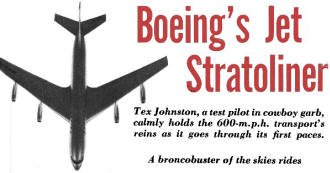 A broncobuster of the skies rides Boeing's
Jet Stratoliner A broncobuster of the skies rides Boeing's
Jet Stratoliner
Tex Johnston, a test pilot in cowboy garb, calmly holds the 600-m.p.h. transport's
reins as it goes through its first paces.
By Andrew R. Boone
Tex Johnston is tall and rangy and he can spit into a 40-mile wind. He wears
a cowboy's high-heeled boots and big hat, and he can spin you yarns from sunup to
supper without repeating himself. And there is something else about Tex - when it
comes to flying, he knows just about as much as there is to know.
When I chatted with Tex recently in Seattle, he was getting set to pull back
on the control yoke and soar aloft in the fastest passenger-type air-plane the world
has ever seen.
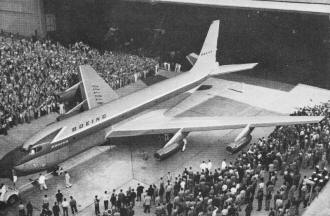
Speed Is in Every Line of the big, new brown-and-yellow
Stratoliner, seen below as it was first rolled out of its hangar. Model above shows
how it looks from overhead.
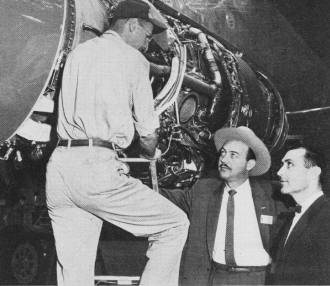
Jet Planes Are an Old Story to Tex Johnston
(in the hat, natch), who was in the driver's seat when both the B-47 and B-52, USAF
jet bombers, made their maiden flights.
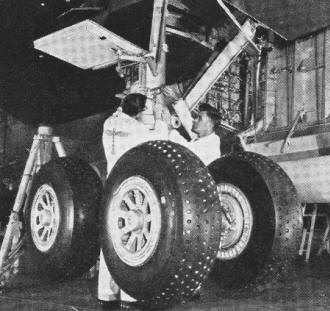
Big Feet for a Big Bird, the eight main wheels
of the Stratoliner are mounted on two sets of tandem axles (left set, above). There
are also two wheels under the plane's nose.
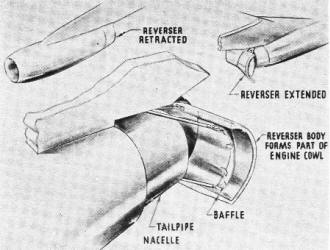
New Kind of Brake, a retractable device that
reverses the thrust of each jet engine without requiring reduced throttle, has been
designed to slow the Stratoliner for landing.
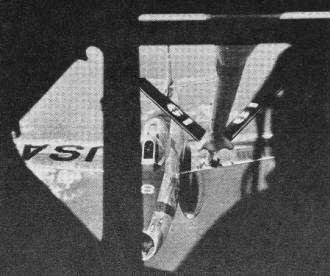
Refueling in Flight can be done at 500 miles
an hour at 40,000 feet, and at far greater distance from home base, when Stratoliner-type
planes are used as tankers.
It would be the first flight of the first model of America's first jet airliner.
Tex Johnston, chief of flight testing for the Boeing people, allowed as how he
would get this here flying machine unglued from the runway and mosey on upstairs
and see how many knots she could make.
Slide Rules Predict Performance
The fact is, he already had a pretty good idea. He and the engineers had figured
it all out ahead of time. Unless the slide rules were plumb loco, this airplane
would turn up some 600 miles an hour in high gear and cruise at around 550.
Tex would be testing an airliner that - sooner than you imagine, maybe - will
be flying from Los Angeles to New York in less time than it takes a fast train to
make it from New York to Boston. It will be able to fly the Atlantic in the time
it takes a motorist to drive from Kansas City to St. Louis.
Eastbound, with the prevailing winds, it will span the continent nonstop in about
four hours. Westbound it may require an hour more. These speeds will chop three
hours and 15 minutes off the present fastest west-to-east transcontinental flights
and three hours off the fastest east-to-west flights.
How They Compare
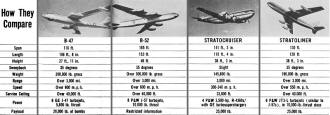
This airliner will fly twice as high as present propeller-driven airliners-up
to 40,000 feet, or almost eight miles, of altitude. Jets have to fly high. At low
altitudes, their speed rapidly diminishes. Jets need rare air to do their best.
Passenger Capacity Will Be Large
There will be a lot of other things about this particular airliner that Tex will
be proving out this summer as he gets those spike heels and fancy-sewed toes on
the rudder pedals. For one thing, it will carry a lot of people. Tex and his side-kicks
don't know exactly yet, but they won't be surprised if it proves capable of toting
125 to 130 passengers. That's 45 to 50 more than the biggest of the current airliners
will accommodate.
Then there is the way they plan to slow the Stratoliner down, once it's out of
the air and in its landing run. They are going to turn the stream of jet gases from
the engines around to blow the other way - and get aerodynamic braking by jet reaction.
Aerodynamic braking has a king-size by-product that may, in the end, prove to
be one of the main reasons why jet transports are practicable. Here's the story:
Drawback: Slow Thrust Recovery
The gas-turbine engines used in jet aircraft turn up five or six times as many
revolutions a minute as piston engines. When they begin losing revolutions, their
power to propel an airplane - that is, their thrust-drops off alarmingly. Worse,
they don't react instantaneously to opening the throttle, as piston engines do.
It takes precious seconds for them to recover their speed and thrust.
If the pilot of a jet airplane "misses an approach" - if he isn't at the right
height, at the right speed, when the near end of the runway flashes by underneath
- it's touch-and-go on his thrust as he pours on the coal to go around and try it
again.
Yet he has to reduce his thrust to get slowed down to land. That's where the
aerodynamic braking comes in. By controlling the direction-of-flow of the gases
from the tailpipes of the new airliner, the pilot can slow down or speed up the
airplane at will without changing the speed of rotation on the engines. Instantaneous
maximum thrust is his for the asking.
Drop-Off Engines
Tex Johnston has other safety devices at his command as he wrings out the new
transport according to the syllabus of the test program. One of them sounds plain
crazy - the engines are attached to the plane in such a way that, under certain
circumstances, they can drop right off. They are swung on fixtures below the huge
wing. If an engine gets out of hand, vibration and the wrench of suddenly frozen
torque will cause it to slip its moorings. It's installed that way. It can go sailing
off into space without rupturing any of the main structure of the airplane. A valve
controlled from the cock-pit shuts off the fuel supply. It's that simple.
Some other aspects of jet-transport flying are not. Noise is one of them. For
all that the airplane and engine manufacturers have been able to do, jets are still
a lot noisier than propeller airplanes. They roar - to people aground.
And jets are hot. When airline jets become operational in the U.S., Mother will
have to keep Junior away from the tailpipes as the aircraft fire up. At full throttle,
the gases issuing therefrom run a temperature of 350 degrees F. at a velocity of
475 miles an hour-a full 25 feet away.
Passengers Can't Get Shakes
As anyone knows who has read accounts of flying in the British Comets - grounded
recently for a review of design and performance in view of some accidents - jet
flying is as smooth as silk. Unlike that in propeller aircraft, there is no vibration.
Nor, for most of the passengers, is there any noise. There is only the swish of
a giant surf, the friction of the wind on the fuselage. Passengers sitting aft do
get a faint echo of the bellow of the jets.
Tex Johnston's new jet airplane is not actually a transport. It's decked out
experimentally as a tanker plane for a long-range bomber fleet. As such, it's being
tested with an eye to selling it to the U.S. Air Force. But the airplane is shaped
like a transport, and Boeing is going to put it through its proving trials with
a transport in mind, too.
Appropriately, the company has decided to call its jet transport the Stratoliner.
The airplane's immediate predecessor was the Stratocruiser, a common sight in the
skies of Reykjavik and Rio, Singapore and San Francisco. There was a previous Stratoliner.
It was the first of the U.S. four-engine land transports. But only nine were manufactured,
and that was 15 years ago.
When will you be able to fly in the first American jet transport? That depends.
The Stratoliner must go through its proving trials. It must be approved for carrying
people. It must be built in numbers so that a regular service can be established
by one or more airlines.
Project tor the "Dream Department"
There are straws in the wind. Captain Eddie Rickenbacker, head of Eastern Air
Lines, was so interested in jet transports that he flew to England to look at the
Comet. Pan American World Airways has an order in for jets. The dreams department
of United Air Lines has been making theoretical jet flights from coast to coast
every day for more than a year. Other U.S. transport-airplane manufacturers are
planning jet airliners.
It wouldn't be a bad guess that you will be able to buy a ticket on U.S. jet
transport by a year from next summer, maybe sooner.
Meantime, hearken to that drawl out Seattle-way. It's Mr. A. M. (Tex) Johnston
giving sweet-talk to 95 tons of jet airplane as he eases forward on the throttles.
It's likely that he's saying to his co-pilot, "Jest you settle back in yore seat
and relax, son, because hyer we go!"
Posted April 13, 2024
|